If you’ve been here before, you have definitely seen me rave about La Roche-Posay’s Cicaplast Baume B5.
The reason for this is that this particular product has absolutely carried my skin through thick and thin, including allergic reactions to testing beauty products, tretinoin-induced irritation, and purging, and whenever my skin needs that extra boost of softness and glowiness, which is pretty much all the time.
However, I’ve discovered another ultra-popular product that many people who use tretinoin or Accutane swear by, and that is Eucerin’s Aquaphor Healing Ointment.
So, I thought I would compare the two side-by-side and see which one I like better.
I am not convinced that anything can top my beloved Cicaplast Baume B5; however, I’ll try to be as unbiased as I can in this review and present the things I liked and didn’t like about both products.
Therefore, and without any further ado, this is my La Roche-Posay Cicaplast Baume B5 vs. Eucerin Aquaphor review, where I will give my honest opinion on these healing ointments, talk about their pros and cons, and who I think would benefit more from each product.

La Roche-Posay – Cicaplast Baume B5
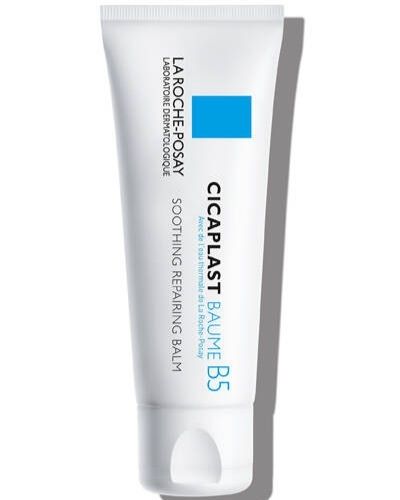
La Roche Posay’s Cicaplast Baume B5 is a calming cream that can be used on cracked, chapped, dry, and irritated skin to help hydrate and soothe.
It’s suitable for adults and children and can be used on all areas of the face and body.
Ingredients
This thick balm contains many soothing, repairing, and moisturizing ingredients.
Some of the main ones include softening shea butter, hydrating glycerin, soothing and repairing panthenol, nourishing magnesium, anti-inflammatory zinc, as well as Madecassoside, which is one of the four main compounds in the plant extract Centella Asiatica, a soothing and repairing agent that helps strengthen the skin barrier.
The Cicaplast Baume B5 is also non-comedogenic, and although it’s quite thick and heavy, it doesn’t contain ingredients that can clog your pores and cause your skin to break out.
Scent
The Cicaplast Baume B5 doesn’t have added fragrance or other fragrant components such as essential oils, and it doesn’t have any scent.
Consistency
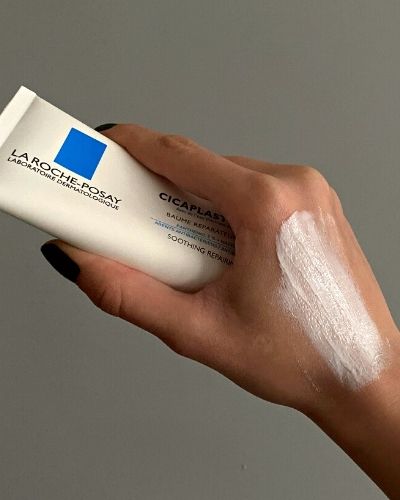
The Cicaplast Baume B5 has the consistency of a thick, creamy balm.
Therefore, before applying it to your face, you need to warm it up between your fingertips until it starts to melt. Otherwise, spreading it around won’t be easy since it has a thicker consistency than a regular moisturizer.
Performance
So the first thing I have to say about this product is that the Cicaplast Baume B5 is not a moisturizer, and it shouldn’t be used as such because you will probably hate its consistency and not get the best results from it.
I like to use it by warming it up between my fingertips and pressing it into the skin in various areas of the face and neck.
That said, the Cicaplast Baume B5 does exactly what it says it does, and it’s always pleasant to see a product being true to its claims.
I started using the Cicaplast Baume B5 when my skin was experiencing extreme dehydration, dryness, peeling, irritation, and purging due to starting tretinoin, and I can confirm it was the product that helped eliminate these side effects.
I used to apply the Cicaplast Baume B5 before bed, 20-30 minutes after applying tretinoin, and I would feel immediate relief from dryness and irritation.
Cicaplast Baume B5 also helped strengthen my skin barrier and even helped smooth out rough skin texture caused by excessive dehydration.
It also helped soothe inflammation, and my purge-induced pimples always looked slightly better in the morning after using the Cicaplast Baume B5 the previous evening.
Additionally, besides using it as a moisturizer every evening, I will sometimes use it as a mask by applying a thicker layer than usual and sleeping in it.
The masking method makes my skin incredibly soft, smooth, and radiant in the morning, so if you are dealing with excessive dryness and irritation, I would highly recommend you try this out.
All that said, there’s one claim I disagree with, and that is Cicaplast Baume B5 not being greasy, according to La Roche Posay’s website.
Yes, this isn’t a greasy oil or a petroleum-based product, but it does leave the skin very moisturized and glowy, which is why as someone with oily skin, I only use it in the evenings to avoid shine during the day.
This claim isn’t necessarily incorrect; however, I know that folks with oily skin expect a velvety or a slightly matte finish when we read a product is “non-greasy,” and this one definitely leaves a glowy layer on the skin.
La Roche-Posay Cicaplast Baume B5 Pros:
- Instantly calms the skin and relieves irritation.
- Helps soothe active inflammation and acne.
- Softens skin texture and helps rebuild the skin barrier.
- Excellent for those who are using tretinoin or acne medication such as Accutane.
- Free of irritating fragrance and drying alcohol.
La Roche-Posay Cicaplast Baume B5 Cons:
- Can make the skin oily throughout the day, which is why it’s best to use it at night.
Eucerin Aquaphor Healing Ointment
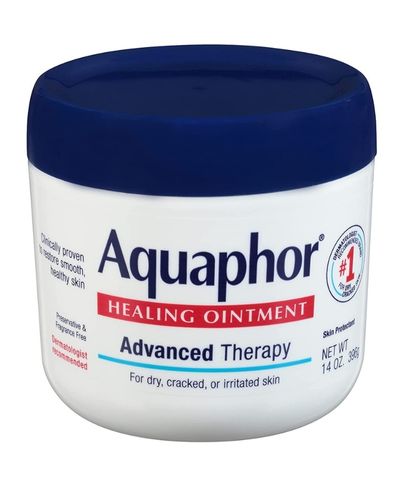
Eucerin’s Aquaphor Healing Ointment is a water-free ointment that repairs, protects, and soothes dry to very dry, cracked and irritated skin. It’s an occlusive, which means it will create the ideal protective barrier to support skin regeneration.
Ingredients
Aquaphor Healing Ointment only consists of seven ingredients.
Its main active ingredient is Paraffinum Liquidum, or paraffin oil, which is a complex mixture of highly refined saturated hydrocarbons. When applied to the skin, it acts as a great emollient and an occlusive that helps seal moisture into the skin and prevent trans-epidermal moisture loss.
This is a great ingredient for those who are dealing with dry and cracked skin, eczema-prone skin, allergies, or those who live in extremely cold climates that can cause the skin to become severely dry.
Other than that, the Aquaphor Healing Ointment is quite oily, also containing lanolin alcohol, a fatty alcohol that’s beneficial for dry and chapped skin, as well as bisabolol, which is the active component of chamomile that gives it its anti-inflammatory and soothing properties.
Scent
Aquaphor Healing Ointment doesn’t have any added fragrance or other fragrant components such as essential oil, and it has no scent.
Consistency
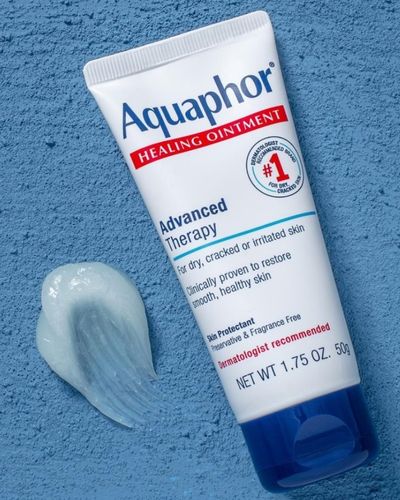
Aquaphor Healing Ointment is, simply described, Vaseline with a slightly lighter texture. It’s solid when you scoop it out of the jar but melts quickly when you warm it up between your hands and apply it to your skin.
Performance
Right off the bat, I am going to say that I don’t like this product. It’s not necessarily because it’s a bad product, but because the consistency and the Vaseline-like feeling is something I personally don’t like on my skin.
I use the Aquaphor Healing Ointment on my elbows, knees, and heels, but using it on the face has always given me the ick just because of the consistency.
I’m also not a fan of paraffin oil and fatty alcohols in general, although they can be beneficial for someone who has excessively dry skin.
Paraffin oil isn’t necessarily a comedogenic ingredient because it works by forming an occlusive layer on the skin’s surface and its molecules are so large to even penetrate into the pores to clog them.
However, this can be a problem because it can trap bacteria, sebum, and other impurities underneath and indirectly cause acne.
Additionally, anything that contains paraffin oil isn’t the best option to use around the eyes and eyelids because it can lead to the formation of millia, which are tiny white bumps that form when dead skin cells and sebum become trapped under the skin.
Aquaphor Healing Ointment also contains lanolin alcohol, which, as I already said, is a fatty alcohol that acts as an emollient and skin softener.
However, my skin doesn’t react well to lanolin alcohol or to any fatty alcohol found in skincare products whatsoever. They are too heavy for my skin and cause me to break out.
But I will say that Aquaphor Healing Ointment is a very effective occlusive and does an excellent job at keeping the skin soft and smooth.
However, I personally don’t like this product for my skin, and I don’t recommend it for those who are prone to acne unless they are taking strong acne medication such as Accutane, in which case Aquaphor can definitely be a good option to help the skin deal with excessive dryness.
Eucerin Aquaphor Healing Ointment Pros:
- Excellent for dry and damaged skin barrier.
- Can be great for those undergoing acne medication.
- Softens the skin and relieves irritation.
Eucerin Aquaphor Healing Ointment Cons:
- Might not be suitable for those with acne-prone skin.
- Heavy and occlusive texture.
Which One is Better for Acne?
If you have active acne and are not taking any medication that would cause your skin to become dry and sensitive, the La Roche-Posay Cicaplast Baume B5 is a better option.
You can use it as a moisturizer or an overnight mask to soothe inflammation and soften the raised bumps.
Cicaplast Baume B5 is also non-comedogenic and won’t exacerbate your acne, which is something that the Aquaphor Healing Ointment could do.
On the other hand, both products are great for dry and sensitive skin that’s also dealing with acne; however, the texture of the Cicaplast Baume B5 is far better than the Vaseline-like feeling of the Aquaphor Healing Ointment.
Which One is Better with Tretinoin?
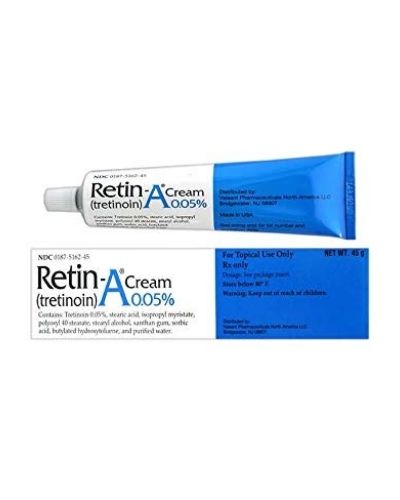
Tretinoin is a prescription-strength topical retinoid that’s used to tackle a variety of skin issues, including acne, hyperpigmentation, texture, discoloration, and signs of aging such as fine lines and wrinkles.
However, tretinoin comes with a few side effects that usually appear at the beginning stage while your skin is getting used to the potent active ingredient.
These include dryness, irritation, peeling, flaking, and purging, which is a process where the active ingredient causes your skin to push out all the impurities that are deep down in your pores, resulting in exacerbated breakouts that usually clear up after a few weeks of using tretinoin.
This is why you’d have to choose between the Cicaplast Baume B5 and Aquaphor Healing Ointment, depending on what you are using tretinoin for.
If you are using tretinoin to get rid of acne, the Cicaplast Baume B5 is a better option as it can help soothe and flatten the breakouts that will appear during the purging stage.
On the other hand, if you are using tretinoin to tackle fine lines and wrinkles and you don’t have issues with acne, chances are that your maturing skin will like both Cicaplast Baume B5 and Aquaphor Healing Ointment.
Therefore, it’s best to try them both out and see which one works better for you.
RELATED: Is Tretinoin Good for Cystic Acne?
Which One is Better with Accutane?
Accutane is the strongest medication that’s used to treat acne. It’s a powerful oral retinoid that works by reducing the production of sebum, which is often the cause of acne.
However, Accutane comes with a rather long list of side effects that include dryness, irritation, redness, flaking, increased sun sensitivity, and even nosebleeds in some cases due to the dryness it causes to the body.
But luckily, both Cicaplast Baume B5 and Aquaphor Healing Ointment can help in that situation, so which one you should use depends on your preference and what your skin likes better.
I personally prefer the Cicaplast Baume B5 because it’s less heavy and doesn’t feel as greasy on the skin, but many people have found Aquaphor extremely helpful at relieving the dryness and irritation caused by Accutane.
Additionally, Aquaphor may be a better option if you are experiencing nosebleeds due to Accutane, as this powerful occlusive will help stop the bleeding and heal the area quicker.
If you want to try both, you certainly can, and it wouldn’t hurt. You will quickly realize which one works better for you, and you can stick to that.
RELATED: Is Accutane Good for Hormonal Acne?
Closing Thoughts
To sum it up, both Cicaplast Baume B5 and Aquaphor Healing Ointment are great for dry and sensitive skin; however, the La Roche-Posay Cicaplast Baume B5 will always be my favorite due to the more elegant texture and the instant relief it provides once applied to irritated and inflamed skin.
Aquaphor won’t give you that instant relief, but it will certainly help heal the skin over time, which is why it’s a great option to have on hand, especially if you’re using it in conjunction with tretinoin or Accutane.

My name is Simone and I am a certified skin specialist. I created this website to teach my readers how to take great care of their skin and I also like to occasionally share my honest opinions on skincare products I’ve tried. You can learn more about me here.
